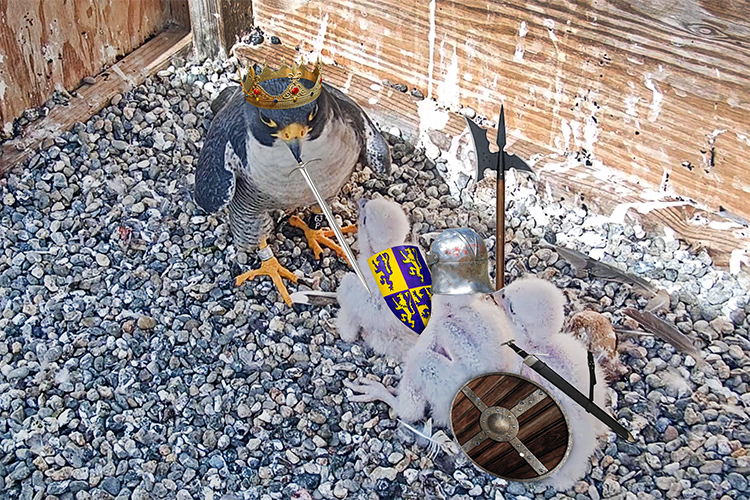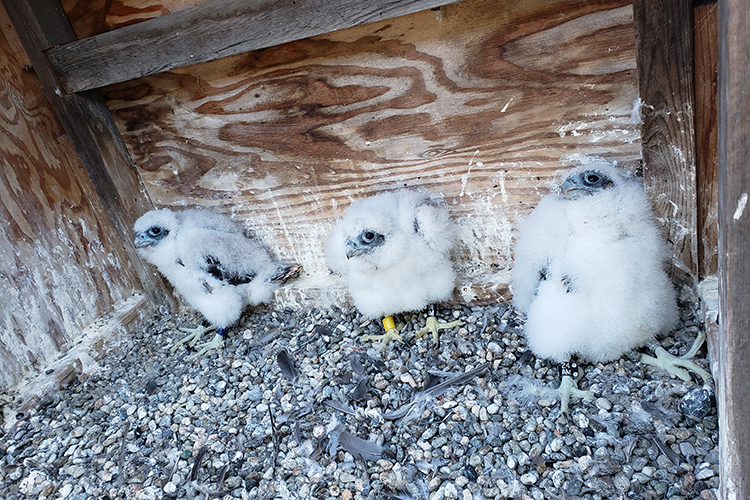UC Berkeley’s three baby falcons need names. Can you help?
Join today's 2 p.m. Cal Falcons Q&A and see video of the chicks being banded; chick-naming contest starts May 12
May 11, 2020

Grinnell, or, in this photo, Sir Grinnell, the father falcon on campus, is preparing to dub his three new chicks, perhaps as knights, with new names. They will be chosen in a contest that starts May 12 and is open to the public, including children. (Photo-edited image by Cal Falcons/Sean Peterson)
An annual spring ritual at UC Berkeley is back: Naming the peregrine falcon chicks born on the Campanile. Starting tomorrow (Tuesday, May 12), members of the public can propose names for the babies hatched last month — two males and one female — through the Cal Falcons Instagram, Facebook and Twitter accounts. Names can be submitted through Friday, May 15.
The top four suggestions — one from each of the three social media accounts and one from children — will be announced on Saturday, May 16, with votes on the finalists allowed through Monday, May 18. The winning names will be revealed on Tuesday, May 19. (See complete contest details here).
Four-time falcon parents Annie and Grinnell hatched Fiat and Lux in 2017; Berkelium, Californium and Lawrencium “Larry” in 2018 and Carson and Cade in 2019.
This morning, the chicks were banded. An aluminum, government-issued ID band printed with each bird’s equivalent of a U.S. Social Security number was placed on one leg, and a black plastic band with a unique code — one letter and two numbers in larger font — was placed on the other, for easier identification from a distance.
This afternoon at 2 p.m., Sean Peterson and Lynn Schofield, the couple who runs the Cal Falcons social media project, will hold a livestreamed Q&A session as viewers look at footage of the banding that was taken earlier today.

The chicks, after they were banded on May 11, each sport an aluminum, government-issued ID band — with the bird’s equivalent of a U.S. Social Security number on it — on one leg and a black plastic band — printed with a unique code of one letter and two numbers in larger font — on the other, for easier identification from a distance. (Photo by Mary Malec)
The banding was done by Zeka Glucs, director of the UC Santa Cruz Predatory Bird Research Group and head of a long-term falcon monitoring project across Northern California. Mary Malec, a local volunteer raptor nest monitor, accompanied her.
“Banding is one of the best scientific tools for learning about how birds survive in the wild and where they move across the country and the continent, and how they’re doing,” said Schofield, a biologist. “With Bay Area peregrine falcons, 19% of the banded birds get found again. Although that sounds low, it’s plenty to statistically determine how many have likely survived and remained in the area and which falcons go on to reproduce themselves.”
The timing of the banding is when the chicks’ feet are fully grown — it’s the first part of their bodies to grow to adult size, an awkward look — and before they become very mobile. Schofield said their feet grow large quickly so they can defend themselves by flipping up their feet and pointing their talons at a predator when their parents are absent. Each chick’s gender was determined based on the width of the chick’s legs just above the toes. Most female raptors have larger feet than males.
Currently, Annie and Grinnell are not spending as much time in the nest as they have previously.

Zeka Glucs, director of the UC Santa Cruz Predatory Bird Research Group and head of a long-term falcon monitoring project across Northern California, bands one of the three falcon chicks born on campus this spring. She determined, based on the width of the three chicks’ legs just above the toes, that there is one female and two male chicks. Females have bigger feet. (Photo by Mary Malec)
“It’s pretty much the Chick Show at the tower,” said Peterson, a Berkeley Ph.D. student in the Department of Environmental Science, Policy and Management. “Annie and Grinnell are both there and keeping their eye on the chicks, but because the chicks aggressively ask for food, even if they’ve eaten, the parents sometimes hide.”
He said Grinnell continues to do most of the hunting, and that Annie stays closer to the chicks and feeds them, although Grinnell was seen feeding the babies a few days ago.
The recent interloper — a juvenile female falcon that showed up at the nest earlier this spring, either to visit or to try and steal Annie and Grinnell’s territory — has not returned to the Campanile. But there’s another problem: Peterson and Schofield said that drones have flown near the nest lately and are a serious problem that must stop.
“The past two weeks, we’ve had a couple people flying drones near the Campanile, which is not good for the falcons,” said Peterson. “The falcons could attack the drones, or the drones could hurt the falcons.”
The chicks will start fledging in about three weeks, he said. For now, they’re moving around awkwardly, but it won’t be long before they’re walking on the tower’s balcony.
“One of the chicks left the nest box on Sunday morning for the first time,” said Peterson, “so they’re just starting to explore the area.”